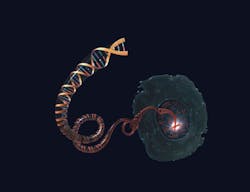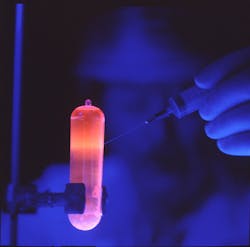BIOPHOTONICS/BIOMANUFACTURING: Biomanufacturing: Engineering a currency for the bioeconomy
The US bioeconomy, which includes genetically modified crops and biologics, is quantified at more than $250 billion.1 The driver behind this juggernaut is a biological revolution whose end result will be a new form of manufacturing. This notion may sound contrary, but biofabs—foundries that produce biological components, devices, and systems—are springing up across the globe. Some, like Blue Heron Biotech (Bothell, WA), which offers gene synthesis services based on its GeneMaker technology, are privately supported. Others, including the Synthetic Biology Engineering Research Center (SynBERC) at the University of California, Berkeley, which leverages optical-based technologies, among others, are public-private partnerships.
"Next-generation manufacturing may be the real biotechnology 'killer app,'" according to Richard A. Johnson, CEO of Global Helix (Washington, DC), a consulting firm specializing in strategic policy issues related to innovation. Much like the foundries established to support the semiconductor industry, these biofabs are creating the currency for this century's bioeconomy. Their work will standardize the tools, parts, and processes to manipulate an organism's genetic material, interchange elements, and consistently insert and delete those elements. And biophotonics are playing an enabling role in this work.
As biomanufacturing accelerates, companies participating in this sector will need to retool their business models. Rather than looking inward for new ideas and technologies, these firms will have to embrace ideas and technologies from outside their companies. They will also have to loosen their hold on intellectual property. Instead of isolation, collaboration—through public-private or university-industry partnering—will provide new opportunities to create enabling technologies.Boosts for biomanufacturing
Although the marketplace will determine the economic success of biomanufacturing, the federal government plays a critical role in helping establish the sector's foundational tools. In an effort to coordinate federal programs in biomanufacturing, the U.S. government has developed the Bioeconomy Blueprint. Issued by the Office of Science and Technology Policy (OSTP), the roadmap provides guidance for the more than 20 federal agencies that support biological research.
To ensure a robust U.S. bio-innovation enterprise, the roadmap recommends:
• Federal R&D efforts to engage multidisciplinary teams, and funding opportunities that include novel mechanisms such as prizes and challenges to support high-risk/high-reward research;
• Agencies that integrate entrepreneurship into university research programs to accelerate commercialization of bio-related research;
• Regulatory agencies that expand their efforts with stakeholders to accelerate review times and reduce barriers to innovation; and
• Increasing the number of pre-competitive, collaborative partnerships between the federal government, universities, and industry.
The document also calls for improvement of worker training programs, including a focus on computer training and other skills needed to sustain the bioeconomy.
The roadmap draws on recommendations delivered by the National Research Council report A New Biology for the 21st Century. Specifically, it states that "coordinated Federal efforts to integrate biology with other sciences—namely physics, chemistry, and computer sciences" as well as mathematics and engineering—will help solve challenges faced in health, energy, environment, and agriculture.
The largest public investment
To achieve biomanufacturing's promise more rapidly, the U.S. Defense Advanced Research Project Agency (DARPA) created the Living Foundries program. Established in 2010, the program handed out nearly $20 million in its first major awards in summer 2012 to key players in the synthetic biology arena: Stanford University, Massachusetts Institute of Technology (MIT), California Institute of Technology, the Foundation for Applied Molecular Evolution, the J. Craig Venter Institute, Harvard University, and the University of Texas at Austin. Alicia Jackson, program manager in DARPA's Microsystems Technology Office, which oversees Living Foundries, has called the effort "the largest public investment in the field."
The grantees are creating basic biological components, tools to manipulate those components, as well as design and assembly techniques to generate platform technologies for use in multiple applications. DARPA anticipates that this comprehensive approach will slash production times from more than seven years to a year or less. According to DARPA, "Living Foundries aims to compress the biological design-build-test cycle and expand by 100-fold the complexity of systems" that researchers can design and engineer.
Bio-optics enablers
Bio-optics techniques will play a key role as enabling technologies in biomanufacturing. One group also supported by Living Foundries is headed by Brian Chow, a bioengineering professor at the University of Pennsylvania. Chow and his colleagues design genetically encoded reagents for use in controlling the physiology of cells through light activation. Known as optogenetic tools, the reagents allow the researchers to direct such processes as neural electrical activity and cellular signaling.
The group is applying optogenetics as a method to interrogate complex biological circuits in engineered cells. Their work could help create nanofactories to produce biological and chemical compounds on demand.
The entire bio-manufacturing enterprise demands that its principals attack problems with creativity and sometimes unconventional solutions. The payoff is developing game-changing advances in the fields of health, energy, the environment, and agriculture. According to Johnson, the challenge will be scaling up many of these innovations to commercially competitive levels that bend cost curves and create demand.
REFERENCE
1. R. Carlson, Biodesic 2011 Bioeconomy Update, http://1.usa.gov/VyNhP1 (accessed Nov. 2012).
About the Author


